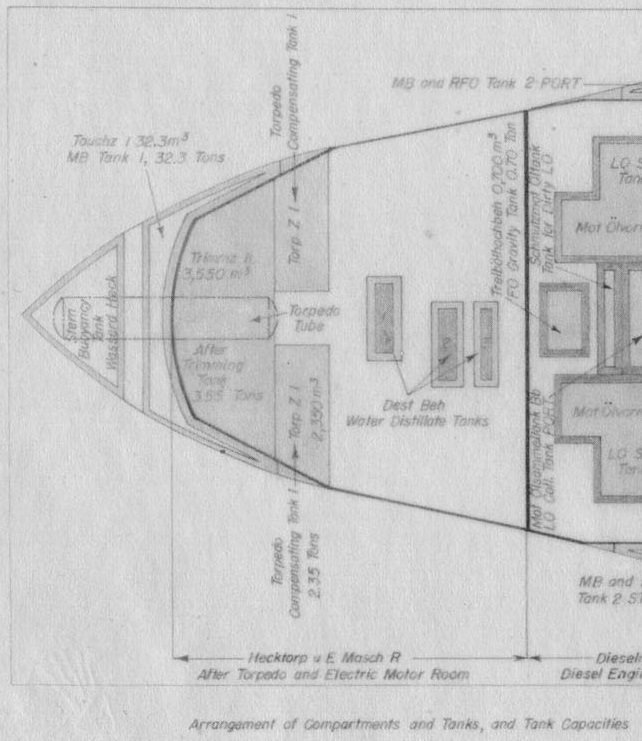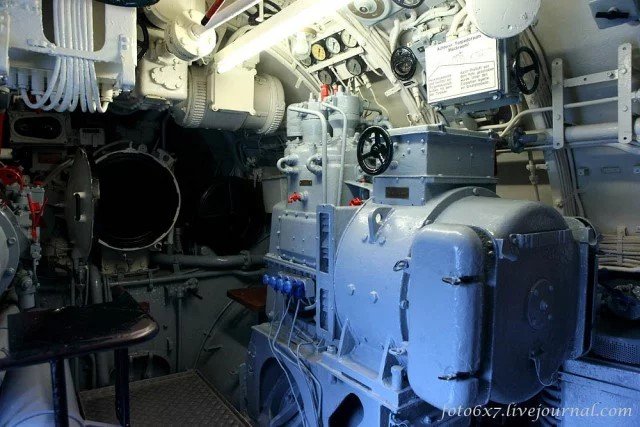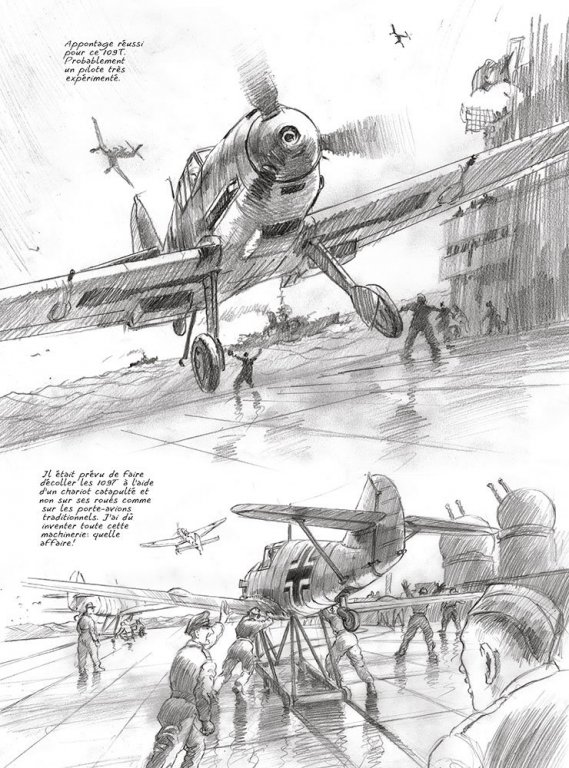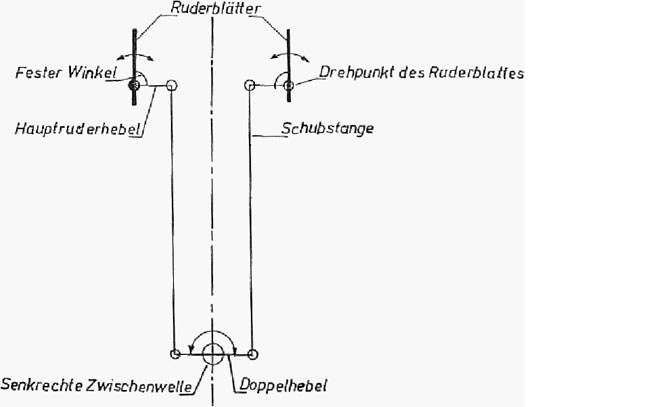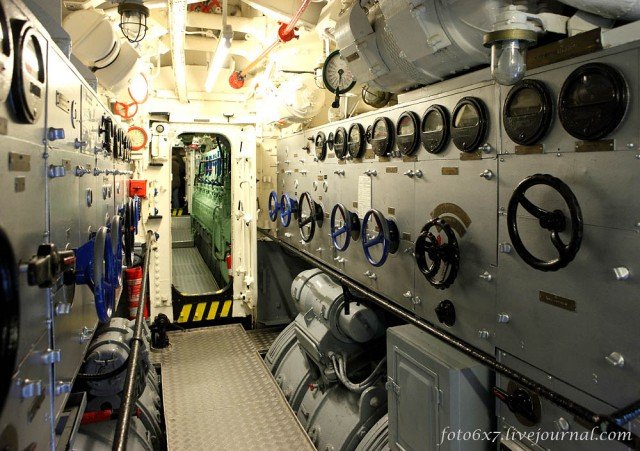-
Posts
3,600 -
Joined
-
Last visited
Content Type
Profiles
Forums
Gallery
Events
Everything posted by yvesvidal
-
Still working on the rear compartment. Installation of the LEDs: four of them connected in series. That should give us close to 10.8 Volts: The electrical compressor is pretty much done: Yves
-
The Electric Compressor, pimped up a little bit. It should be a four stages compressor, but Trumpeter forgot the second cylinder.... The Rear torpedo tube on its platform and the canister containing the mines: Finally, the electric panel to control the propulsion motors: Lots of detail remain to be placed and painted. Yves
-
Our next efforts are focused on the Rear torpedo tube, electric compressors and torpedoes compensation tanks. A summary of the stern tanks seems on order to explain the rear compartment: The Trumpeter kit provides one of the compensation tanks (2.35 tons of salt water), one electric compressor and the torpedo tube. Once again, it is very spartan and it is regrettable that no additional parts are provided in the kit, as these two components would not detract the viewer from the intricacies of the compartment. Below is a picture of what we are talking about, from the U-995 submarine. The large compressor sits on top of the torpedo compensation tank. The torpedo tube is visible on the left of the picture. To the extreme left is the other diesel compressor installed on the U-995, sitting on the other compensation tank. Not visible, to the right of the torpedo tube is a large canister containing mines and other "goodies" that can be launched using the ejection tube. Underneath the metal floor, is the torpedo stowage area for one eel, sitting right between the two electric motors. On the early Type VIIc units, there was two electric compressors. The German engineers replaced the starboard electric compressor later on by a diesel unit, as the electric consumption was way too important with both electric compressors. It is not clear if U-552 has two electric or a combo electric/Diesel compressors. From the manual: a) Electric air compressor. The compressed air required for blowing ballast tanks, starting diesel engines, for torpedo launching installation, anchor installation and so on, is produced by two electric, 4-stage air compressors, located in the aft torpedo room. Their performance is 6.1 liters/minute at 205 kg/cm². Compressed air from each stage is cooled down in a cooler. The air cooler and lubricating oil cooler are located in one case outside the compressor. The compressor is cooled by sea water. The two-stage cooling water pump is located on the coupling side of compressor and is driven by means of helical gears from the crankshaft. The gear type lubricating oil pump is located on the front side of compressor at its base plate and is driven from the crankshaft by means of gear wheels. The compressor is driven by a direct current, shunt electric motor, with starting compound winding on commutating poles. The motor is splash-proof and self-cooled with air. b) Diesel air compressor. Type VIIC U-boats since Boat No. ____ are provided with one electric air compressor and one diesel air compressor. The diesel air compressor is a horizontal, double piston, two-stroke diesel engine with free pistons which are directly coupled with a four-stage compressor. Its performance is 8.5 liters/minute at 205 kg/cm². After compression the air from each stage passes through a condenser for cooling. The cooler for all four stages is located beneath the compressor in individual cases. The air is cooled by means of sea water. The cooling water pump, rotary vane type, driven by a gear shaft, forces the water in the following order: cooler IV, combustion chamber cooling jacket, compressor stage I, compressor stage IV, cooler III, compressor stage III, compressor stage II, cooler I, cooler II. The lubricating oil pump, driven by means of an eccentric from the gear shaft, lubricates all sliding parts. The compressor is driven by two-stroke diesel engine made by Junkers, with two opposed pistons, which are coupled together by means of two sets of traverses, two gear racks with a geared wheel located between them. Engine pistons control intake of air, which is compressed and exhausted. The stage I compressor piston is connected with left engine piston, the stage II compressor piston is connected with right engine piston. The stage IV compressor piston is coupled with the left piston rack and the stage III compressor piston is coupled with the right piston rack. The compressor is started by means of compressed air admitted to particular compressor stage chambers. The compressor casing is splash-proof. c) High pressure compressed air flasks. Compressed air is stored in 12 high pressure air flasks with total capacity of 3.900 m3. Each flask has capacity of 325 liters and is tested at pressure of 280 at. The flasks are grouped in 6 banks (2 flasks each), which are located as follows. Bank 1 Upper deck aft, on both sides of the aft external torpedo container Bank 2 Upper deck, above the diesel engine assembly patch Bank 3 Petty officer's room port and stb. Bank 4 Forward torpedo room to port Bank 5 Forward torpedo room to stb. Bank 6 One flask in the bow buoyancy tank, one flask on the stb. side forward of the external torpedo container. The flasks are smooth shaped and are lined with lead. On both ends they narrow into the neck, capped by means of flange and cover. To drain the flask a drainage pipe is provided in the deepest point of flask. Furthermore, the flasks are inclined 4 degrees from the horizontal. Yves
-
The ceiling of the rear torpedoes / electric motors room, is pretty much done: Decals have been added on the dials and indicators. When dry, I place a few drops of clear-coat to simulate the glass lenses. The wheel is used in case of emergency and failure of the main steering system. It looks relatively realistic. I am avoiding the dirty / patina presentation as most of these vessels were well maintained during their short lives, at least in the inside. Yves
-
Greg, I hope you do not mind me posting these pictures here, but the Italian Artist Perinotto just published the Tome 4 of his drawings with two very interesting drawings: Notice the carriage/cart holding the Me-109, and used as a catapult on the deck of the Graf Zeppelin. Very advanced technology. Yves
- 345 replies
-
- graf zeppelin
- trumpeter
-
(and 2 more)
Tagged with:
-
Gorgeous and so unique work. Your model is truly a jewel and you are an artist. I love the uniqueness of that approach, even though I am far from being able to do what you did with the Mikasa. The paint is for me a way to hide the imperfections of my models and the lack of details sometimes. I have the Mikasa and may one day try to copy you.... Thank you for showing us this great model. Yves
- 34 replies
-
- mikasa
- wave models
-
(and 2 more)
Tagged with:
-
Working on the roof of the rear compartment: The Trumpeter kit is more or less accurate here and there is room for additional details. The holes will host the four white LEDs, the last hole to the left is the rudder control axle. Some of the pipes are original and prototypical, others have been left to the imagination of the artist. The mechanism on the ceiling of the rear compartment is the manual control of the rudders, in case of the failure of the electric systems. A large wheel will take place, once I have painted the ceiling. From the "Manual": 1) Steering System. a) General. The rudder installation includes the following: Two identical main rudder planes parallel to each other, Forward dive planes, After dive planes, Plane drive, Steering stations, Steering lines. Steering plane construction: To keep the driving force low, all steering planes are built as displacement, balanced rudders. They are made from watertight plating on both sides, with stiffeners provided between the plates. The spaces between plates are filled with tarred wood. Steering plane protection: A skeg is provided to protect the main rudder, especially from hitting the bottom, from which two arms lead to both rudders and are attached to the rudder pins. To prevent entanglement with naval mine wires and antisubmarine nets all linkages are made smooth and all faces are rounded. The outer edges of dive planes are protected against naval mine wires. To avoid corrosion (galvanic current between bronze and steel in sea water) all steering planes are provided with zinc protection plates. b) Main rudder installation. The main rudder is twin type and can be either electrically or manually driven. The main rudder is driven by means of vertical intermediate shaft, which passes through the pressure hull between frames 1 and 2 and which is driven by worm gear. The shaft bearing is installed at the pressure hull and is re-tightened from inside by a stuffing box. The top of the intermediate shaft (in the upper-deck) is attached to a double arm, which is connected by means of two long connecting rods with two, center-facing, main rudder arms. Each main rudder has an area of 2.75 m². The rudder maximum deflection is 33° when electrically driven and 35° when manually driven. Ruderblätter Rudder planes Fester winkel Fixed angle Drehpunkt des Ruderblattes Pivot point of rudder planes Hauptruderhebel Main rudder arm Schubstange Connecting rod Senkrechte Zwischenwelle Vertical intermediate shaft Doppelhebel Double arm The maximum deflection of the main rudder and forward and aft dive planes is limited electrically by means of a limit switch and mechanically by means of mechanical limit stop. Yves
-
A few words about the electric motors. Yes, as you may have guessed, I am trying to give some movements to that otherwise static model. The original submarine had two propellers running in a contra-rotating way, as always. I am using small Chinese motors with a high reduction gear, giving me a rotation speed of 40 RPM to 60 RPM, depending of the voltage applied to them (around 6 VDC). Since, the whole model will be powered in 12 Volts, I placed these two motors in series, making sure that they spin in the right direction as the prototype was. The propeller shafts are made of Brass tubes and rods as we saw previously. Because of the extremely slow speed of rotation, there will be no need for bearings of any kinds (or even lubrication). I just may have to hide the rubber tubes that will be used to couple the shafts to the motors. Here is a picture of the electric motor compartment of the U-995: Talking about the "real" electric motors on a Type VIIc, here is an excerpts of the "Manual" : a) Design and performance data. Manufacturer B.B.C. Mannheim A.E.G. Berlin Weight of a machine with fan blower B.B.C. 8100 kg. A.E.G. 8170 kg. Motor rated power: 276/238 kW (60 min/continuous) Rated current: 1470/1240 A (60 min/continuous) Voltage: 210 V Number of revolutions: 295/280 RPM (60 min/continuous) Excitation voltage and current: 110 V 28 A Generator rated power: 465kW(continuous) Rated current: 1550 A Voltage: 300 V Number of revolutions: 450 RPM Excitation voltage and current: 110 V 28 A b) Machine construction and connections. The E motors serve as motors to drive the propellers and as generators to charge the batteries. Each E motor is built as a fan cooled, totally enclosed, direct current, double-armature, with compound winding and commutating poles, has 2 x 8 main poles and just as many commutating poles. The motors are designed for forward and backward drive. Both armatures of the E motor can be connected in series or in parallel for drive. If one armature is damaged, the motor can still be driven in parallel connection. Cooling is provided by a blower directly attached to each motor. It draws fresh air from E motor room and blows it into the center of the E motor. The exhausted air is cooled in 2 water-cooled air coolers lying between the E motors. E motor armature connections: Drive setting Setting of the armature Dead slow serial Slow parallel half speed parallel 2 x half speed parallel Drive setting Setting of the armature 3/4 speed parallel 2 x 3/4 speed parallel Emergency speed parallel Yves
-
Thank you Greg for the explanations. You did a terrific job: very realistic. Yves
- 345 replies
-
- graf zeppelin
- trumpeter
-
(and 2 more)
Tagged with:
-
I get it and I understand the fun of turning a model into a beat-up ship. Please, document your process and tell us how you do it and what products you use. I want to rust my submarine too, as you suggested in a very early post. Thanks in advance. Yves
- 345 replies
-
- graf zeppelin
- trumpeter
-
(and 2 more)
Tagged with:
-
Do you really need rust on such ship? It did not see much service..... But again, I know you are doing a representation in a different time line (what if...?) Yves
- 345 replies
-
- graf zeppelin
- trumpeter
-
(and 2 more)
Tagged with:
-
Please, don't smash it. This is a very rare kit. We all understand your frustration, as it gets unbearable at times. Breathe, relax, listen to the birds and forget about the kit for a little while. Yves
-
Some small progress with the installation of electric motors. Just to give you a sense of what is being prepared: Joanna (from Trumpeter) has not responded yet. Let's face it, she probably will never do. The platform is painted with Vallejo Stainless Steel and re-enforced underneath with two strips of 0.080 x 0.080 from Evergreen. That makes it a lot more realistic. Yves
-
Really impressive. That is a monster. Yves
- 345 replies
-
- graf zeppelin
- trumpeter
-
(and 2 more)
Tagged with:
-
Yes, I checked Shapeways and they are way overpriced for custom jobs. Even their parts for submarine kits at 1/48 scale are rather expensive, although beautifully made. I also looked into molding plastic parts. That is a whole new world for me and I am not sure I can do that with success. For the time being I am going to go with my own fabrication and try to disguise it in the best possible way. Maybe Joanna in China will respond one day.... Some progress on the rear compartment. This is how the kit is built: All the good stuff is hidden from view. Very poor design from Trumpeter. Then only one electric motor/generator is provided. That is the parts that are the most difficult to recreate. My implementation will be very approximate for a good reason. I have replicated the three ribs provided in the kit and placed the original parts in the front. The rear part are absolutely non visible, once the compartment is completed. The roof section was presenting a large opening, perfectly visible. It was necessary to remedy to it. Finally, the bulkhead with the electric motor stands and torpedo storage platform: We will see how to go from there. Yves
-
Yes, I have checked a lot of things on the Internet. It is not a common kit (due to its size and price) and thus the odds are not in my favor. I also have sent three E-mails to Joanna@trumpeter-parts.com with no answer so far. She must be vacationing in Paris or too busy to answer. So, I have decided to move along and fabricate the parts myself. It will not be as nice as the molded parts (far from that), but since they will be behind, it may be acceptable for the time being. If I ever find some spare sprues, I can always rework the rear module. Yves
-
Folks, I am afraid there won't be much updates for a while. I am debating how to build the rear electric motor compartment and wish to present both motors. Trumpeter really simplified this compartment with just one motor and very few other parts. I suspect that this was their last module and they probably had too much rice alcohol in their system, when designing it. They could have included both motors, both clutches and both shafts but decided to go cheap and not provide them. I am trying to obtain spare parts from Trumpeter and that is a major challenge. Some people have made it, most could not get anything. I have also contacted one person who built that same kit, without the interior and offered to purchase the internal parts. There, again, no response. I may have to fabricate the parts myself, but it will never reach the level of precision of the molded injected parts. So, I am revamping the compartment, to place in the front what would have been relegated to the back of the module (a la Trumpeter). If anyone has a lead to purchase sprues X, Y and V, please let me know. Ideally, and if I could afford it, it would be worth buying two kits, keeping some sprues and re-selling the rest for someone who wishes to build the external hull only. Decisions, decisions...... Yves
-
Another excerpts of the "Manual", explaining what are the five modes of the propulsion plant. The Support and Buffer mode is particularly interesting and very advanced in its behavior: Inter-operation of the engines and motors. a) General. The diesel engines provide a maximum surface speed of about 18 knots and both E-motors provide a submerged speed of 8 knots. The different working modes are listed below: Diesel engine only drive, E motors only drive, Support and buffer mode, Diesel-electric drive, Charging mode. Exhaust gas from both diesel engines can be diverted and used for blowing out the main ballast tanks and main ballast and reserve fuel oil tanks. b) Diesel engine only drive. In diesel engine only drive; both diesel engines drive the propellers via the diesel engine couplings, E motors, main couplings, thrust shafts and the propeller shafts. In this arrangement the E motors are just a part of the drive train and the armatures are un-powered. The fan blowers of the E motors rotate slowly powered by voltage generated due to the remanent magnetism of the un-powered rotating armature. c) E motors only. With E motor drive only, the diesel engine coupling is un-clutched. The E motors are powered by the battery and work as motors driving the propellers via the main couplings, thrust shafts and the propeller shafts. d) Support and buffer mode. In support mode, the output power of the diesel engines is increased by switching on the E motors additionally. Each diesel engine via the diesel engine coupling and in addition each E motor acting as a motor drives the propeller. The buffer mode is used in rough seas. The diesel engines drive the ship's propellers as in "Diesel engine only drive". The E motor voltage is adjusted such that with normal conditions the loading and discharge current are equal to zero. If the screw runs above the surface, thus causing unintentional reduction of load on the diesel engine, the E motor works as a generator preventing an inadmissible increase in diesel RPM. e) Diesel-electric drive. Diesel-electric drive allows driving both propellers even if one diesel engine has failed. The operational diesel engine works directly driving the propeller on its side. The E motor whose armature would normally run idle, works as a generator delivering power to the other ship side. The E motor on the other side drives the propeller; the diesel engine clutch is disengaged. The current from the primary E motor can either be switched in such a way that it only drives the secondary E motor or an additional light charge of the batteries takes place. f) Charging operation. Charging operations can be differentiated as follows: Charging with a disengaged propeller shaft, Charging while running on the surface with diesel engines. When charging with a disengaged propeller shaft, the diesel engine drives the E motor via the diesel engine clutch. The E motor runs as a generator and charges the storage batteries. When charging while on the surface with the diesel engines; the diesel engine power drives the propeller. At a constant number of revolutions from the diesel engine, the E motor charges the batteries. In this case, the diesel engine must provide power for the propeller and for charging. Yves
-
So, the next construction step will be addressing the rear compartment: Torpedo room and electric motors bay. I managed to find on the Internet, a translation of the original German Type VIIc manual that was provided with each submersible. This manual has nothing to do with what was published by the group of military scientists that captured the U-505 (Chicago Museum of technology) and reverse engineered it. It is the real deal that was given to every German commander to operate their vessel in the Atlantic. It is a mine of information and I will try to publish some excerpts as we move along the construction. The manual was written in German (of course) and has been translated in English by Maciek Florek. It refers to Submarines built in 1939 and thus corresponds to our model of the U-552. The following describes the Machinery and Propulsion Plant. You can see the main Diesel engine, followed by the primary clutch, the electric motor/generator, followed by a second clutch, main thrust bearing, stuffing box, shaft and propeller. Motorwelle Engine shaft Schwingungsdämpfer Flywheel Dieselmotor Diesel engine Dieselmotorkupplung Diesel engine clutch E-Machine welle E Motor shaft Schott 16-1/2 Bulkhead (frame 16-1/2) Maschine 2 Motor 2 E Maschine E motor Maschine 1 Motor 1 Hauptkupplung Main clutch Druckwelle Thrust shaft Hauptdrucklager Main thrust bearing Flanschenkupplung Flange coupling Schraubenwelle Propeller shaft Wellenbremse Shaft brake Stopfbuchse Stuffing box Druckörper Pressure hull Vorderes Stevenrohrlager Forward - Stern tube bearing Hinteres Stevenrohrlager Aft - Stern tube bearing Wellenbocklager Shaft strut bearing Schraube Propeller More details soon. Yves
-
A chaque jour suffit sa peine. Superbe. Yves
- 550 replies
-
- confederacy
- model shipways
-
(and 1 more)
Tagged with:
About us
Modelshipworld - Advancing Ship Modeling through Research
SSL Secured
Your security is important for us so this Website is SSL-Secured
NRG Mailing Address
Nautical Research Guild
237 South Lincoln Street
Westmont IL, 60559-1917
Model Ship World ® and the MSW logo are Registered Trademarks, and belong to the Nautical Research Guild (United States Patent and Trademark Office: No. 6,929,264 & No. 6,929,274, registered Dec. 20, 2022)
Helpful Links
About the NRG
If you enjoy building ship models that are historically accurate as well as beautiful, then The Nautical Research Guild (NRG) is just right for you.
The Guild is a non-profit educational organization whose mission is to “Advance Ship Modeling Through Research”. We provide support to our members in their efforts to raise the quality of their model ships.
The Nautical Research Guild has published our world-renowned quarterly magazine, The Nautical Research Journal, since 1955. The pages of the Journal are full of articles by accomplished ship modelers who show you how they create those exquisite details on their models, and by maritime historians who show you the correct details to build. The Journal is available in both print and digital editions. Go to the NRG web site (www.thenrg.org) to download a complimentary digital copy of the Journal. The NRG also publishes plan sets, books and compilations of back issues of the Journal and the former Ships in Scale and Model Ship Builder magazines.




